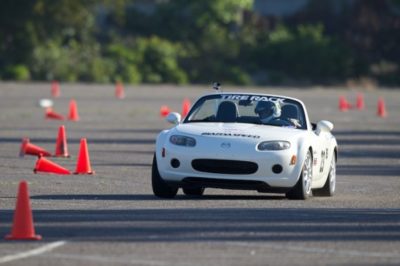6 Benefits to Working with a Solo Teammate
Should you consider a teammate in autocross? We think so. Should you definitely go with one? It’s not for everyone, but like most things in life, there are trade-offs; it is what we make of them that should determine whether to partner-up.
We learned of a team out of the Reno, Nevada area that is known and respected for working well together. We thought we’d start with them. Tomorrow, we will share the “other” stories about the pitfalls you’ll want to avoid when selecting and working with a teammate.
Meet teammates Rachel Kerswill and Ahren Renner. Ahren has autocrossed for three years; he finished 3rd overall and 1st in the E Street Prepared (ESP) class in just his second year competing; though, he did compete in a Prepared Subaru (but has made a better choice, if you ask us, by switching to a Mazda – the most raced brand in autocross, thank you Mazda Family!). His snow skiing background, having competed in the junior Olympics and still coaches, has given him experience in how to break down a course. Rachel started competing at the age of 16 in 2007 in an ‘04 Mazda RX-8; she was able to manage school and remained committed to being successful in the sport. In 2014, she won an SCCA Solo National Championship. Rachel and Ahren teamed up in 2014 looking to compete in the Crow’s Landing National Tour event and the Packwood Tour in 2014.
And now on to the benefits of teaming up:
Benefit #1: Partner to save on costs, particularly travel. Rachel and Ahren were able to take just one car up to Packwood, Washington. Of course, that extends to gas and more.
Benefit #2: Learn about course walking strategies from one another. Their first event was at Packwood. While walking the course, they realized the benefits of another perspective and assistance in tackling each other’s weaknesses. Rachel finished 1st in class that event.
Prior to Packwood, Rachel broke down the course at a national event by walking the course twice the morning she arrived and no more than four times in total. Her first walk was just a cursory walk – initial walk without much stopping and analyzing details. For her second walk, she would pause at elements to review line more closely.
After Packwood, Rachel made adjustments. She walks five-to-six times the day she arrives, and then twice-to-three times the morning of the races. When a difference arises in the racing line, for example, a healthy debate ensues to determine the best line. They typically agree on the line; however, the times they do not, it typically comes down to driving style. Rachel explains, “I drive more with the front of the car; I don’t like it loose. Ahren prefers to break the rear loose on entry, get the car pointed, then squeeze on the throttle. He doesn’t use this style in every corner. But often Ahren may turn a bit later and get rotation; Rachel would turn a bit earlier, get push and manage it with the throttle and wheel.
Rachel understands the benefits of altering driving style for certain cars and corners. But overall, she views rotation as risky. She explains, “The penalty can be high by over sliding. You see it in the times and can ruin an entire lap. In national events when you only get three runs, I don’t find it is worth it. At the regional level, you could get four-to-six runs, depending on the length of the course and other factors. In those situations, I am more aggressive and risky with driving style.”
Benefit 3: While they don’t leverage data during the event, they do use an action camera and view the tape after the event. “Comparing each person’s sessions can be tough to collect useful data or takeaways in order to make adjustments. However, one still can collect some. What can be more valuable, in actuality, is to review your own film, when coupled with lap times,” says Rachel.
Benefit 4: Once the competition begins, a partner can help you stay mentally balanced. Rachel explains, “It is helpful to get reminders about the course and the plan – talking through it, saying things out loud, analyzing what is digestible, and not calling it quits after two course walks. Even pushing one another off the track helps us to better achieve results on it. Don’t let one another sleep-in; be a motivator at all times; well, don’t overdo it, but you’ll find that your mental state adjusts for the better and permanently. The fundamental change to working with a teammate improves your mental state that drives the positive behaviors. Everything happens easier, as a result.”
Benefit 5: Between events, setting up the car with someone who is knowledgeable. Even though styles are different, combining expertise only helps. Rachel elaborates, “It is pretty crucial to get the setup right, primarily, the sway bar, alignment, shocks, and to experiment with different tire pressures between events and during regional action are the ideal times.” During the event, they manage the tire pressures most, since they typically prefer different pressure and setting the right pressure is critical for lap times (for more on tire pressure, BFGoodrich® Tires has an excellent article found here).
Benefit 6: Times will get tough, and a teammate can help pull you out of the trenches. Rachel recalls how luck runs out and funds may get really tight. She jokingly referenced the Wedding Crashers movie where someone, at some point, is going to feel like he or she is taking grenades. “Such is life,” she says. “No one should be left in the trenches alone and a good teammate can be just the answer.”
Tomorrow’s featured article 5 Pitfalls to Avoid when Selecting a Solo Teammate


 ACCESSIBILITY
ACCESSIBILITY